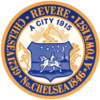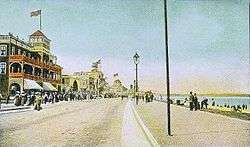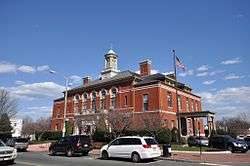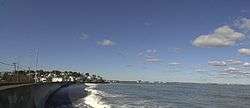Revere, Massachusetts
| Revere, Massachusetts | ||
|---|---|---|
| City | ||
| ||
 Location in Suffolk County and the state of Massachusetts | ||
 Revere, Massachusetts Location in the United States | ||
| Coordinates: 42°24′30″N 71°00′45″W / 42.40833°N 71.01250°WCoordinates: 42°24′30″N 71°00′45″W / 42.40833°N 71.01250°W | ||
| Country | United States | |
| State | Massachusetts | |
| County | Suffolk | |
| Settled | 1630 | |
| Incorporated | 1871, 1915 | |
| Government | ||
| • Type | Mayor–Council | |
| • Mayor | Brian Arrigo | |
| Area | ||
| • Total | 10.0 sq mi (26.0 km2) | |
| • Land | 5.9 sq mi (15.3 km2) | |
| • Water | 4.1 sq mi (10.6 km2) | |
| Elevation | 20 ft (6 m) | |
| Population (2010)[1] | ||
| • Total | 51,755 | |
| • Density | 8,772.0/sq mi (3,386.9/km2) | |
| Time zone | Eastern (UTC-5) | |
| • Summer (DST) | Eastern (UTC-4) | |
| ZIP code | 02151 | |
| Area code(s) | 339 / 781 | |
| FIPS code | 25-56585 | |
| GNIS feature ID | 0612810 | |
| Website |
revere | |
Revere is a city in Suffolk County, Massachusetts, United States, located approximately 5 miles (8.0 km) from downtown Boston. It is named after the American Revolutionary War patriot Paul Revere.[2] As of the 2010 United States Census, the city has a population of 51,755 inhabitants.[1]
Revere borders the towns of Winthrop and Chelsea, and the Boston neighborhood of East Boston to the south, Everett and Malden to the west, Saugus and Lynn to the north, and the Atlantic Ocean to the east. According to the United States Census Bureau, the city has a total area of 10 square miles (26 km2), of which, 5.9 square miles (15 km2) of it is land and 4.1 square miles (11 km2) of it (40.98%) is water.
History

Revere’s first inhabitants were Native Americans who belonged to the Pawtucket tribe and were known as the Rumney Marsh Indians. The leader, or sachem, of the Pawtuckets was Nanepashemet of Lynn. In 1616, an epidemic, probably smallpox, swept the region, killing thousands in its wake. Nanepashemet retired to the Mystic River, in what is now Medford, but was found murdered in 1619 at his fort on the brow of Rock Hill overlooking the river. Three sons succeeded him in his reign. One of them, Wonohaquaham, also called Sagamore John, had jurisdiction over the Native Americans at Winnisemmit (later Chelsea) and Rumney Marsh.
Often, the Native Americans, with their intimate knowledge of the vast, yet unexplored wilderness, would help the settlers in their struggle to survive. During King Philip's War, the local friendly Native Americans were placed on what is now Deer Island, where many of them perished. Some of them on the island were enlisted to help the colonists defeat the other warring tribes.
Rumney Marsh was originally divided and allotted to twenty-one of Boston's most prominent citizens. By 1639, the original allotments had been consolidated into seven great farms. Farming was the principal industry of Winnisemmet, and Rumney Marsh in particular. On September 25, 1634, Rumney Marsh was annexed to Boston, which had received its name only four years earlier. Winnisemmet and Pullen Poynt (which was later to be known as Winthrop) were also annexed to Boston. The first county road in North America stretched across Rumney Marsh from the Winnisemmet Ferry to Olde Salem in 1641.
In 1739, Rumney Marsh, Winnisemmet and Pullen Poynt were set off from Boston and established as the town of Chelsea. The largest of the three settlements, Rumney Marsh (or North Chelsea) was selected as the Town Center.
In 1775, the area played a role in the American Revolution as the site of the first naval battle, at Rumney Marsh, and other locations.
In 1852, Pullen Poynt seceded from North Chelsea and was established as the town of Winthrop. That same year, Chelsea became its own city. In 1871, North Chelsea changed its name in honor of the great American patriot, Paul Revere, who died in 1818.
On the morning of July 28, 2014, an EF2 tornado touched down in nearby Chelsea and intensified as it entered the city of Revere, causing major damage to many buildings, including the Revere City Hall. Damaged cars, power outages, downed lines and downed trees were reported all around Revere, Chelsea, Winthrop and Boston.[3] It was the first tornado to hit Suffolk County since the National Weather Service began keeping records in 1950.[4]
Demographics
| Historical population | ||
|---|---|---|
| Year | Pop. | ±% |
| 1850 | 935 | — |
| 1860 | 921 | −1.5% |
| 1870 | 1,197 | +30.0% |
| 1880 | 2,263 | +89.1% |
| 1890 | 5,668 | +150.5% |
| 1900 | 10,395 | +83.4% |
| 1910 | 18,219 | +75.3% |
| 1920 | 28,823 | +58.2% |
| 1930 | 35,680 | +23.8% |
| 1940 | 34,405 | −3.6% |
| 1950 | 36,763 | +6.9% |
| 1960 | 40,080 | +9.0% |
| 1970 | 43,159 | +7.7% |
| 1980 | 42,423 | −1.7% |
| 1990 | 42,786 | +0.9% |
| 2000 | 47,283 | +10.5% |
| 2010 | 51,755 | +9.5% |
| 2014 | 54,157 | +4.6% |
| * = population estimate. Source: United States Census records and Population Estimates Program data.[5][6][7][8][9][10][11][12][13][14] Source: | ||
As of the 2010 United States Census,[16] there were 51,755 people residing in the city. The racial makeup of the city was 62.4% White, 4.9% Black, 5.6% Asian, 0.4% Native American, 0.025% Pacific Islander, 11.7% from other races, and 3.3% were multiracial. Hispanic or Latino persons were 24.4% of the population (5.8% Salvadoran, 4.9% Colombian, 3.7% Puerto Rican, 1.9% Mexican, 1.5% Guatemalan, 1.3% Dominican).
As of the same census, there were 47,283 people, 19,463 households, and 11,872 families residing in the city. The population density was 7,994.2 people per square mile (3,089.0/km²). There were 20,181 housing units at an average density of 3,412.0/sq mi (1,318.4/km²).
There were 19,463 households out of which 25.5% had children under the age of 18 living with them, 41.8% were married couples living together, 13.9% had a female householder with no husband present, and 39% were non-families. 32.7% of all households were made up of individuals and 12.4% had someone living alone who was 65 years of age or older. The average household size was 2.41 and the average family size was 3.09.
The population was spread out with 21% under the age of 18, 7.9% from 18 to 24, 32.6% from 25 to 44, 21.8% from 45 to 64, and 16.6% who were 65 years of age or older. The median age was 38 years. For every 100 females, there were 93.6 males. For every 100 females age 18 and over, there were 89.9 males.
The median income for a household in the city was $37,067, and the median income for a family was $45,865. Males had a median income of $36,881 versus $31,300 for females. The per capita income for the city was $19,698. About 11.9% of families and 14.6% of the population were below the poverty line, including 20.4% of those under age 18 and 10.4% of those age 65 or over.
Foreign-born population
As of 2010, 27% of the residents of Revere were born outside of the United States. Many of them originate from Asia, Europe, and Latin America. The 2010 percentage of foreign born is twice that of 1990.[17]
Sites of interest
Revere Beach
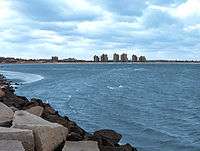
Revere Beach is the oldest public beach in the United States. It has a fairly active beach front district. From its inception, Revere Beach was "the people's beach", used mostly by the working class and the many immigrants who settled in the area. The Revere Beach Reservation Historic District was listed on the National Register of Historic Places in 1998, including the full Revere Beach Reservation in 2003.
The Beach began to deteriorate in the 1950s and by the early 1970s it had become a strip of honky-tonk bars and abandoned buildings. The Great Blizzard of '78 proved to be the final death knell for the "old" Revere Beach, as many of the remaining businesses, amusements, pavilions, sidewalks, and much of the seawall were destroyed.
The area once boasted an extensive array of amusement rides and attractions. The Whip, the Ferris wheel, Bluebeard's Palace, the Fun House, Hurley's Dodgems, the Pit, Himalaya, Hippodrome, Sandy's, the Wild Mouse, the Virginia Reel and many more provided hours of enjoyment for residents and visitors alike. The biggest attraction was the Cyclone, among the largest roller coasters in the United States. Built in 1925, its cars traveled at speeds of up to 50 miles per hour (80 km/h) and its height reached 100 feet (30 m).[18] Also notable was the Derby Racer racing roller coaster, which had a series of accidents that killed or critically injured riders between 1911 and 1936. Lightning was another roller coaster at Revere Beach, and was a member of Harry Traver's infamous "Terrifying Triplets". In addition, there were two roller skating rinks, two bowling alleys, and numerous food stands. There were also ballrooms, including the most famous, the Oceanview and the Beachview, each the site of many dance marathons which were popular in the 1930s.
The Beach was the focus of a major revitalization effort by the Massachusetts Department of Conservation and Recreation and the City in the 1980s and was officially reopened in May 1992. It now boasts high-rise housing units, a re-sanded beach, restored pavilions, and a renovated boulevard. Revere commemorated the centennial of the first opening of Revere Beach on the weekend of July 19, 1996.
Historic places
Revere has eight places on the National Register of Historic Places.
Kelly's Roast Beef

Kelly's Roast Beef is a fast food eatery founded in Revere in 1951. Its main location is along the Revere Beach shoreline. Kelly's claims to have invented the modern roast beef sandwich, saying it was unknown as such before they introduced it in 1951.[19][20]
Necco
Considered the oldest continuously operating candy company in the United States, Necco is best known for its namesake candy, Necco Wafers, its seasonal Sweethearts Conversation Hearts, and brands such as the Clark Bar and Haviland Thin Mints. The company maintains its headquarters at 135 American Legion Highway in Revere, where it offers tours of the facilities.
Wonderland Greyhound Park
Wonderland Greyhound Park was a greyhound racing track located in the city owned by the Westwood Group. It was constructed on the site of the former Wonderland Amusement Park. Wonderland opened on June 12, 1935 and formerly offered 361 performances during its 100-day, April to September racing period. Parimutuel wagering was legalized by the Massachusetts Legislature in 1934. The Park opened the following year and offered greyhound racing from June 1935 until September 2009. It ran its last program on September 18, 2009, as a result of a statewide referendum that banned greyhound racing. The future of the land is uncertain.
Transportation
The completion in 1838 of the Eastern Railroad (later the Boston & Maine), and in 1875 of the Boston, Revere Beach & Lynn Railroad, signaled the beginning of rapid population growth for the town and the development of the beach as a summer resort. By 1885, ten years later, the town had increased to 3,637 inhabitants, more than tripling in size over 15 years. By 1890, the population had grown to 5,668.
In 1871, Revere was the site of The Great Revere Train Wreck of 1871, the deadliest railroad incident in Massachusetts history, when the Eastern Railroad's "Portland Express" slammed into the back of a stopped local commuter train at Revere Station.
The MBTA Blue Line terminates in Revere, with stops at Wonderland, Revere Beach, and Beachmont.
U.S. Route 1 and state highways 1A, 16, 60, 107, and 145 run through Revere.
Education
Revere Public Schools operates the city's public schools. High school students can attend either the Revere High School, Northeast Metropolitan Regional Vocational High School or the Seacoast School. There are three public middle schools. Private PK-8 schools include both Eagle Heights Academy and Immaculate Conception.[21]
Notable people
See also Category:People from Revere, Massachusetts
- Horatio Alger, Jr., author
- Elliot Aronson, psychologist
- Elizabeth Bishop, poet
- John Cazale, actor
- Robin Christopher, actress
- Billy Conigliaro, professional baseball player
- Tony Conigliaro, professional baseball player
- Glenn Danzig, singer-songwriter
- Jim Del Gaizo, professional American football player
- Adio diBiccari, sculptor
- Gerald Jordan, businessman
- M-Dot, musician
- Gino Martino, professional wrestler
- Roland Merullo, author
- Zack Norman, actor-producer-financier
- James Sokolove, attorney
- Henry Waitt, cigar manufacturer
See also
References
- 1 2 "2010 City Population and Housing Occupancy Status". U.S. Census Bureau. Retrieved June 6, 2011.
- ↑ City of Revere History
- ↑ Wright, Bruce (28 July 2014). "Tornado Rips Through Revere". Boston Globe Media Partners, LLC. The Boston Globe. Retrieved 29 July 2014.
- ↑ Morrison, Sara (28 July 2014). "Tornadoes of Massachusetts Past". Boston Globe Media Partners, LLC. The Boston Globe. Retrieved 29 July 2014.
- ↑ "TOTAL POPULATION (P1), 2010 Census Summary File 1". American FactFinder, All County Subdivisions within Massachusetts. United States Census Bureau. 2010.
- ↑ "Massachusetts by Place and County Subdivision - GCT-T1. Population Estimates". United States Census Bureau. Retrieved July 12, 2011.
- ↑ "1990 Census of Population, General Population Characteristics: Massachusetts" (PDF). US Census Bureau. December 1990. Table 76: General Characteristics of Persons, Households, and Families: 1990. 1990 CP-1-23. Retrieved July 12, 2011.
- ↑ "1980 Census of the Population, Number of Inhabitants: Massachusetts" (PDF). US Census Bureau. December 1981. Table 4. Populations of County Subdivisions: 1960 to 1980. PC80-1-A23. Retrieved July 12, 2011.
- ↑ "1950 Census of Population" (PDF). Bureau of the Census. 1952. Section 6, Pages 21-10 and 21-11, Massachusetts Table 6. Population of Counties by Minor Civil Divisions: 1930 to 1950. Retrieved July 12, 2011.
- ↑ "1920 Census of Population" (PDF). Bureau of the Census. Number of Inhabitants, by Counties and Minor Civil Divisions. Pages 21-5 through 21-7. Massachusetts Table 2. Population of Counties by Minor Civil Divisions: 1920, 1910, and 1920. Retrieved July 12, 2011.
- ↑ "1890 Census of the Population" (PDF). Department of the Interior, Census Office. Pages 179 through 182. Massachusetts Table 5. Population of States and Territories by Minor Civil Divisions: 1880 and 1890. Retrieved July 12, 2011.
- ↑ "1870 Census of the Population" (PDF). Department of the Interior, Census Office. 1872. Pages 217 through 220. Table IX. Population of Minor Civil Divisions, &c. Massachusetts. Retrieved July 12, 2011.
- ↑ "1860 Census" (PDF). Department of the Interior, Census Office. 1864. Pages 220 through 226. State of Massachusetts Table No. 3. Populations of Cities, Towns, &c. Retrieved July 12, 2011.
- ↑ "1850 Census" (PDF). Department of the Interior, Census Office. 1854. Pages 338 through 393. Populations of Cities, Towns, &c. Retrieved July 12, 2011.
- ↑ "Census of Population and Housing". Census.gov. Retrieved June 4, 2015.
- ↑ "American FactFinder". United States Census Bureau. Retrieved 2008-01-31.
- ↑ Sacchetti, Maria. "A melting pot stretches out to the suburbs." Boston Globe. September 15, 2010. p. 1 (Archive). Retrieved on September 23, 2014.
- ↑ RevereBeach.com History page Accessed 2008-08-30 Archived August 1, 2008 at the Wayback Machine
- ↑ Kennedy, Louise, "At Kelly's, roast beef sandwiches rule", The Boston Globe, May 18, 2011
- ↑ Cf. "Kelly's History", company website
- ↑ "Revere Middle Schools - Revere, MA | GreatSchools". Retrieved 2012-06-08.
External links
| Wikimedia Commons has media related to Revere, Massachusetts. |
| Wikisource has the text of the 1911 Encyclopædia Britannica article Revere. |
- Official website
- Revere Chamber of Commerce
- Revere Beach
- The Revere Journal
- Revere Society for Cultural and Historic Preservation
- Visit Revere
- Revere Community Portal
| |||||||||||||||||
| ||||||||||||||||||||||||||
